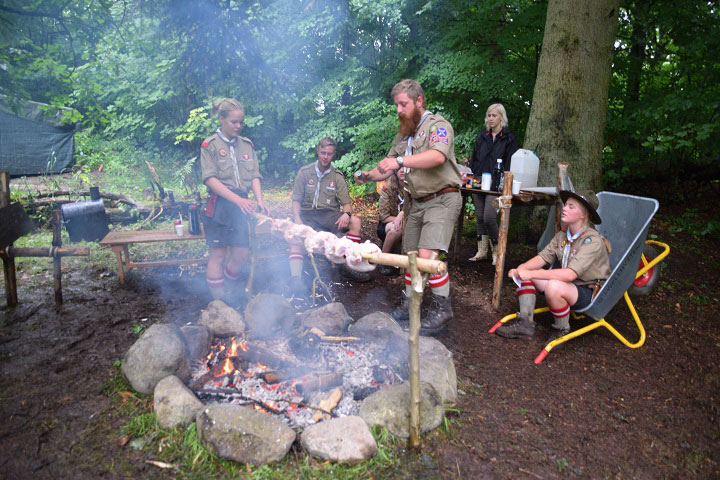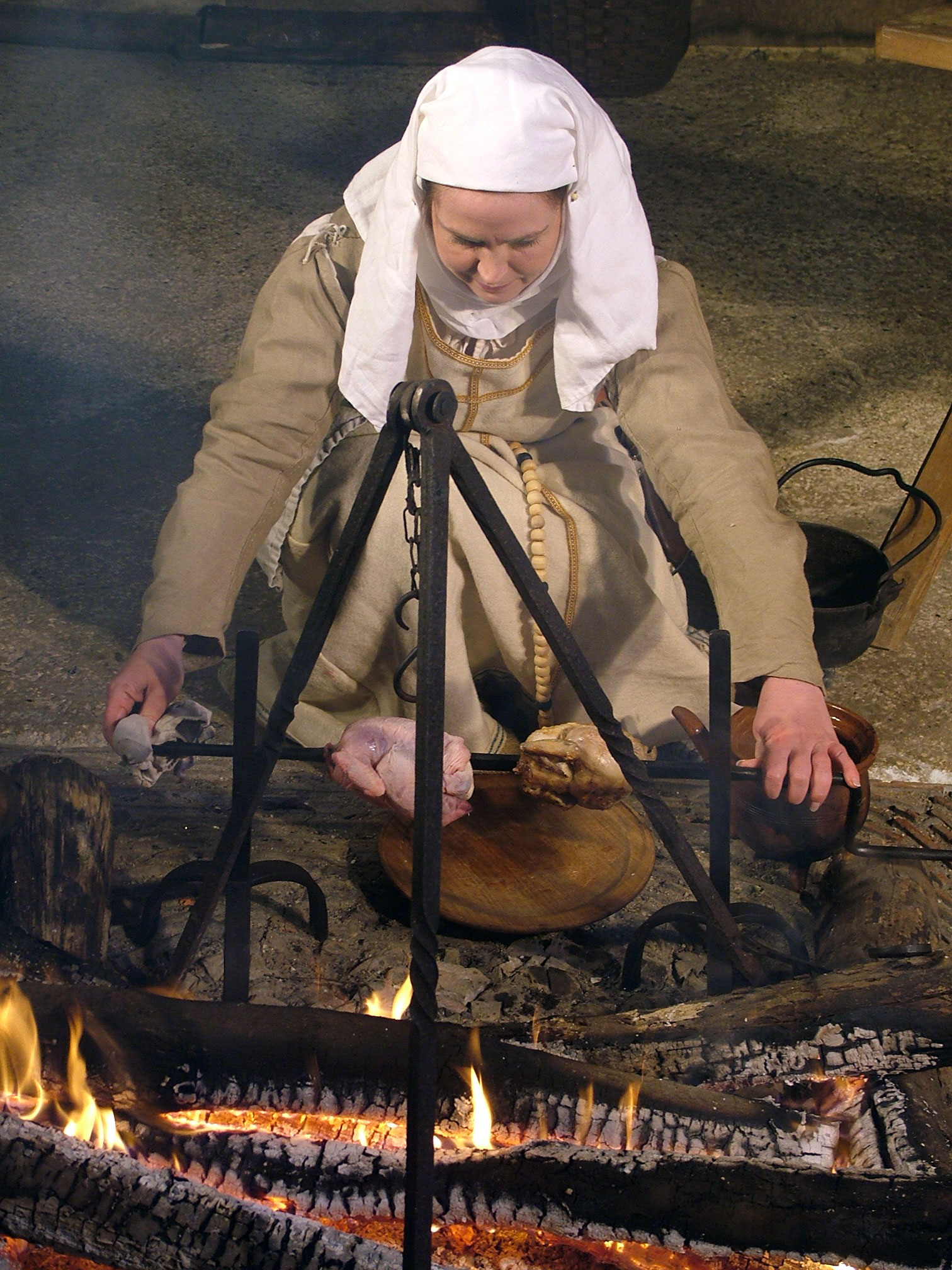Any medieval household with a surplus of small children might use them to guard flocks of geese. Eating off grass during summer, they might be fattened in the autumn supplying the household with either an extra bit of cash or a delicious treat. In the Middle Ages, they would have been cooked, stuffed with fruit.
Take sage, parsley, thyme and savory, and mix it with quinces and pears, garlic and grapes, and stuff the geese with this. Sew the hole[s] that no fat escapes. Roast him well and keep the grease that drips from it. Take a fond and some fat and cook it in a small pot. When the geese have roasted enough, take them off [the spit] and cut them into pieces, and take what is in it and return it to a small cooking pot. Add wine if it is too thick. Add thickener, sweet spices (ginger, cinnamon, mace, bay leaves, and cloves), and salt. Boil the sauce, and dress the geese on dishes and pour the sauce over.
From: C.B. Hieatt en S. Butler, Curye on Inglysch (Middle English recipes) (Early English Text Society Supplementary Series), London, 1985, pp.

Reading this recipe, it is obvious the royal cook at the court of Richard II of England (1367 – 1400) aspired to serve a dish with a fat bird, freshened up with the sour taste from fruits of the middle ages, mixed with sweet spices. It must be remembered that medieval fruits were tangy and not as sweet as they are today. Tangy grapes from your own garden may do the trick when you try to recreate a medieval taste. Or you may just enjoy the fact that you live at a period in history when gardens flow over with sweet and delicious fruits.
If you wish to cook the goose in an authentic manner, it is not complicated to build a long-fire outside and erect a stand, by using forked branches and a fresh green offshoot as a cooking spear. Or you might go for it and build your own medieval kitchen!
Judging by the number of recipes, geese were a delicious treat, which was not too hard to come by in a well-to-do household.
How to Cook a Medieval Goose in a Modern Oven
First be sure your goose or duck has been cleaned out properly. This is done by checking whether giblets have been left by accident. If it is free range, you also need to check for stones left in the innards. Next, remove the loose fat near the neck and put aside.
Now season the bird by rubbing the inside with a mixture of pepper and salt.
Take a string of pure cotton and close up the bird by sewing it together at its neck.
Fill it with a mixture of peeled and sliced apples, quinces, pears, plums (dry or fresh), cherries (if in season) as well as seedless grapes through the hole at the neck. You don’t have to peel the plums or grapes. Season the mixture with garlic, parsley, sage, and thyme and fill up the bird as much as possible. Close the rear end by sowing it together.

Roast the bird on a wire rack set upon a baking pan in an oven for 1 hour at 100˚ C with the breast downwards. The fat will slowly melt and drizzle off.
Meanwhile prepare a fond by sizzling the loose fat from the neck, and frying the giblets or innards in a casserole. Add a litre of boiling water, and season with salt and pepper. You might add an onion and a carrot to the fond or galentine, as such sauces were called in the Middle Ages. Or you might cook it the medieval way by adding 1 tsp Galangal, 1/2 tsp cinnamon, 1/2 tsp ginger, and 2 tbsp vinegar (apple or wine) for every 2,5 dl liquid.
After an hour, remove the bird from the oven and let the fat drip off from the baking pan (remember to preserve it, as it is delicious in a pie crust). Then fill the pan with the fond, which you have cooked off the innards, salt the breast of the bird, and return it to the oven for 1½ to 2 hours pending on the size and at 150˚ C (if it is a goose, let it roast for longer). Remember to turn it this time so that the breast turns upwards. You might also cook it slowly for 4 – 5 – 6 hours at 90-100˚ C. Either way, check occasionally to see if it lacks water in the pan.
The bird is done, when the legs feel loose and a prick with a needle near one of these produces a clear liquid.
While roasting, you can baste it with its own fat or you can try out a mixture of 4 tbsp fat and 2 tbsp honey or maple syrup. This leaves a sweet and crackling skin. At the end, you might wish to grill it for a few minutes under full heat (be carefull!)
When done, remove the bird from the oven, cover it with baking paper, and wrap it in kitchen towels, or even a bath towel. Let the bird rest, while preparing a sauce from the dripping from the baking pan adding wine or apple juice as you prefer, and smooth it with breadcrumbs. (If too sour, mix in some double cream).
Remove the filling, cut the bird into pieces, and serve on a large tray with the pieces of the bird in the middle, encircled by the fruity filling. Pending of how thick your sauce is, you might serve it separately or pour it over as the medieval recipe tells us to do.
Goose Baked as a Pie
From Germany, we have a recipe where the goose is baked as a pie
First prepare a piecrust of 1500 gr flour, 9 eggs, 150 – 175 gr fat or butter, 15 gr salt. Let it rest in the refrigerator for 2 hours, while you prepare the goose. Take a small bird, approximately 3 – 3500 gr, and clean it up (see above). Then fill it with a mixture of 750 gr pears (or apples), two lemons, two tsp ginger (freshly grated), 1 tsp crushed pepper, 1 tsp powder of Muscat, 1 tsp powder of cloves, 2 – 3 tsp cinnamon, and 1 -2 tsp salt. Add a bit cumin and 125 gr smoked bacon, hacked into small pieces. Mix well, before filling the bird. The sew it up and place it aside. Roll out the piecrust to a very large oblong piece – large enough to wrap the whole bird. Place the bird on the dough and slip small pieces of lard in between the legs and wings of the bird (to soften where it is liable to dry out). Wrap the bird firmly in the dough. Take care to close it off properly. Cook in a preheated oven for 3 1/2 to 4 hours.
Breasts of Goose Covered in Goose-Liver sauce
Season a goose with a mixture of salt, pepper, powdered fennel seeds, and cumin, mixed with 5 tbs of honey, mixed with a bit of water. Fill the goose with a mixture of 500 gr of pears cut into pieces, 15 gr of juniper berries, 250 gr chopped bacon, a bundle of parsley, 3 chopped onions , pepper and salt. Meanwhile prepare a sauce of 1/2 litre of chicken stock, 1 bundle of green herbs, 200 gr of chicken, duck, or goose liver (chopped and roasted), 2 chopped onions, and 2 – 3 chopped tangy apples, and 4 eggs. Season it with pepper, saffron, cumin, vinegar, and honey. Cook slowly and smooth with breadcrumbs. The texture should be somewhat like hummus. Arrange pieces of the breast from the goose at an oblong plate and cover it with the sauce.
Wild Geese the Spanish Way
Wild geese are abundant visitors along the southern and western coast of Spain. Such birds would be hunted vigorously during the season. The following recipe is slightly reworked from the original, which may be found at the website, The medieval Spanish chef
For this recipe get a wild goose and remove the skin of the breast by slicing it off at the side (above the leggs and wings). As best you can, preserve the skin of the breast in one piece. This is not just a Spanish tradition, but may be found all over Europe. Remove the breast of the goose and put it aside.
Then mix a stuffing made of the chopped innards seasoned with a mixture of crushed spices – anise, cloves, cinnamon and fennel seeds – together with a dash of fish sauce, a dash of juice from coriander, 1,5 dl crushed almonds, 1 dl crushed pine nuts, 1/2 dl pistachios, a pinch of salt, 2 sprigs of chopped mint, 2 sprigs of chopped fennel, 2 tbs olive oil, and four to six eggs. Mix eggs into the stuffing until it seems like meat prepared for meatballs.
Lay one breast on the skin and cover with stuffing. Place five hardboiled egg yolks on top and cover it with the other breast. Then wrap the skin around and sew it up into a sausage.
The point is by stuffing the skin, which you sew together, you can preserve it by salting or smoking and serve it in a sandwich. Or it can be served freshly cooked in a sizzling pot or in the oven (c. 1 hour at 150 -75˚ C)
The rest of the goose may be boiled in order to pluck the meat from the bones. Chop the meat, and mix it with spices and chopped nuts. Form them into meatballs and cook them in sizzling olive oil. A German version of this is to preserve the skin of the neck, which may be filled with the stuffing prepared from the meat, the innards and seasoned either in the Spanish or the German fashion. Germans would typically add breadcrumbs and raisins to the stuffing, while Spaniards would mix it with chopped almonds or nuts.
SOURCES:
READ MORE:
The post How to Cook a Medieval Goose appeared first on Medieval Histories.
Powered by WPeMatico